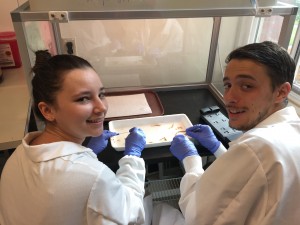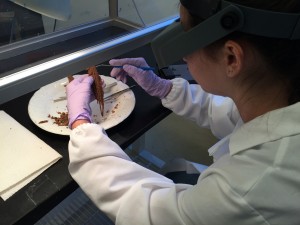Isopropanol is a remarkable preservative. In May, 2015, Brian Sidlauskas, Curator of the Ichthyology Collection in the Department of Fisheries and Wildlife at Oregon State University, loaned me some small fish (northern anchovy and three smelts) that I could process for their bones. I gutted and skinned the fish, then put them in jars with water, trying to macerate them with some soil bacteria, but nothing happened after two months. I even had the jars heating up on my back porch in the hot July sun, and brought them indoors at night. But no putrefaction! No biological activity of any kind! I proceeded to simmer one specimen in a crockpot with a little meat tenderizer…. for 36 hours, then a week… then more. In case you are wondering, this is not a crockpot we use to prepare any human food; it’s one designated for this purpose in my colleague Frances White’s primate osteology lab. Yet the flesh of this small fish remained hard and leathery and we couldn’t dissect it away. So I contacted various colleagues and while Mike Etnier and Bob Kopperl both provided great suggestions, it was Virginia Butler who solved this conundrum. Dr. Butler recommended trypsin, a serine protease enzyme found in the digestive system of most vertebrates. Trypsin is expensive, but it’s worth it, and after 6-8 weeks, it has become possible for my fearless students to remove the flesh from the bones.


 All of this is related to the research we’re doing on small fish; some is related to the Alaska Herring Project, because we find small fish bones misidentified as herring in some collections. And I also hope to identify those Naknek fish I blogged about awhile back. But we’re also studying the small fish in the Tcetxo assemblage from the southern Oregon coast. And so far, I can say that we are finding surf smelt (Hypomesus pretiosus) and northern anchovy (Engraulis mordax) from this site. This indicates that the Tututni speakers of southern Oregon were also smelt fishing like the Tolowa still do today. The analysis is still underway, but thanks to the work of Kyla Page-Bothelo and Leo Hirsch (shown here) and other ANTH 4/571 Zooarchaeology students, we are making progress on the analysis. Special thanks to Rick Minor for making the Tcetxo bulk samples available to us and to Frances White and Steve Frost who have both contributed to this project.
All of this is related to the research we’re doing on small fish; some is related to the Alaska Herring Project, because we find small fish bones misidentified as herring in some collections. And I also hope to identify those Naknek fish I blogged about awhile back. But we’re also studying the small fish in the Tcetxo assemblage from the southern Oregon coast. And so far, I can say that we are finding surf smelt (Hypomesus pretiosus) and northern anchovy (Engraulis mordax) from this site. This indicates that the Tututni speakers of southern Oregon were also smelt fishing like the Tolowa still do today. The analysis is still underway, but thanks to the work of Kyla Page-Bothelo and Leo Hirsch (shown here) and other ANTH 4/571 Zooarchaeology students, we are making progress on the analysis. Special thanks to Rick Minor for making the Tcetxo bulk samples available to us and to Frances White and Steve Frost who have both contributed to this project.